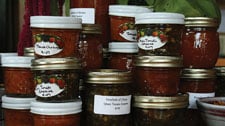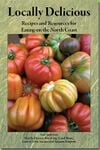Humboldt County has a wide variety of native foods which can be gathered, caught or hunted. Appendix I provides some initial guidance.
Summer provides a bounty of berries. Go for a hike and your snacks are there for the picking. Bring a pail and fill it with blackberries or huckleberries. Go home and make pies, tarts, jam and other treats. Teas are made from some native plants which may already be growing in your yard. Gather seaweed for sushi, pickles and broth.
Fall and winter are mushroom seasons. Regionally, we have a huge variety of mushrooms, many of them edible. Be sure you gather in a legal area and that you know for certain which can be eaten and which are toxic. Guide books and information on the local Mycological Society are in Appendix I.

With many rivers and the ocean nearby, local fish and seafood are available if not always abundant.
And finally, quail, grouse, geese, ducks and deer are among the birds and animals that are hunted in this region. What about winter and early spring?
One of the challenges of eating locally is to find produce and fruit in the winter and early spring. Here are several solutions.
Keep it Growing
Fresh produce will grow throughout the year in a greenhouse. In our temperate climate, many Asian greens can overwinter outside. Broccoli, carrots, celery, chard, collard greens, fennel and kale also grow as winter crops in much of our region.
Storing and Preserving Food
Preserve foods when they are abundant and use them in winter through early spring. A chapter in the recipe section of this book is devoted to food storage and preservation.
Cold Storage is an easy option for foods such as winter squash, onions, garlic and root vegetables. Food can be kept for extended periods of time if kept cold either in a cool room such as a root cellar or in a refrigerator.
Broccoli, corn, cauliflower, green beans and peas freeze well. Freeze sliced apples and berries in a bag. Cut up sweet peppers or onions and freeze them—they’ll be ready for cooking any time of the year. Roast hot peppers and freeze them for later use. Turn vegetables into stock and freeze the stock to use in a mid-winter soup.
Vegetables that pickle well include cucumbers, beets, string beans, carrots, watermelon rind and cabbage (as sauerkraut or kim chee.) Bull kelp can be successfully pickled as well.
Drying is a good option for fruit and tomatoes. Dried apples, plums, peaches or pears make quick tasty snacks. Sun-dried tomatoes are fabulous in appetizers or main dishes.
Jams and jellies are a good place for a novice canner to start. Canning low acid fruits and vegetables, on the other hand, requires much more care. Turn tomatoes into tomato sauce, tomato paste, salsa or pasta sauce, or just can them whole. Can dilly beans, beets, corn, pears, plums or peaches. Apples can easily be made into applesauce. Did you catch a big albacore or salmon? You can also can that for later use. Always make sure to follow canning instructions very carefully to avoid food poisoning. Canning is a science, not an art.
Drying and canning have a further ecological benefit: the food needs no refrigeration, so no additional energy is consumed for storage.

